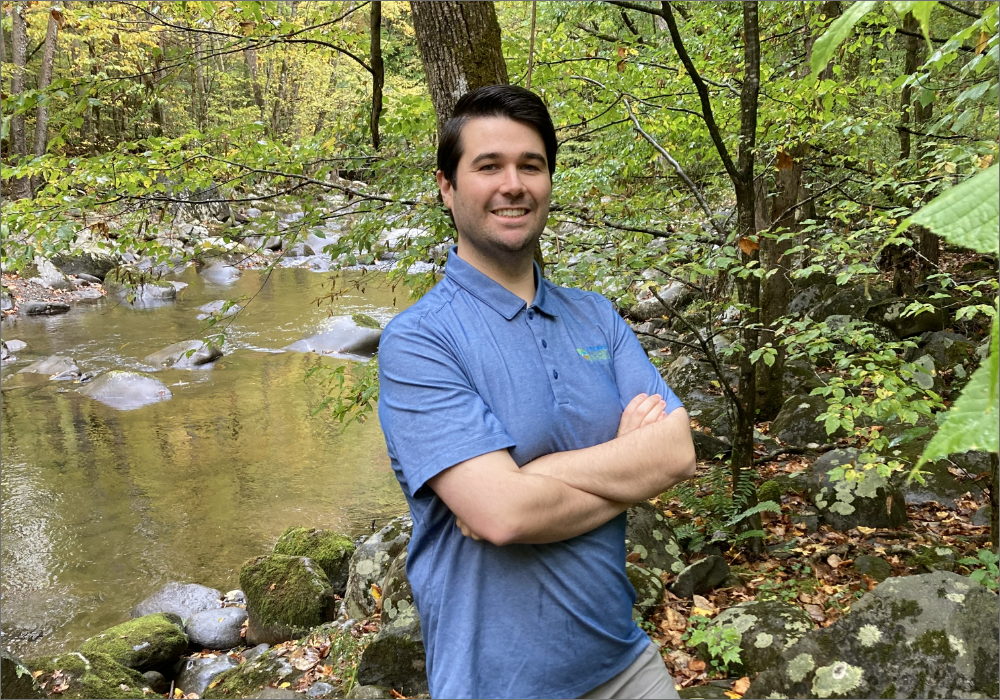
Zane Smith, a PhD student in entomology and plant pathology, is spearheading research on native ash trees in the Great Smoky Mountains National Park, which are under threat of extinction by the Emerald Ash Borer, a green buprestid (or jewel beetle) known to cause up to 99.99% mortality among nearly all affected native ash species.
Smith is one of eight UT students to receive the National Science Foundation Graduate Research Fellowship (NSF-GRFP). His fellowship proposes using genomics to assess ash tree biodiversity, hybridization, and local adaptation. As an NSF-GRFP recipient, Smith is now receiving $147,000 in financial support to continue his research. He expressed, “This is an incredible opportunity that I cannot begin to express my gratitude for.”
Originally from Knoxville, TN, Smith completed his undergraduate degree in modern foreign languages at the University of Tennessee, Knoxville in 2013. After joining his family’s business, a local produce market and garden center after graduation, he decided to return to UT in 2020 to pursue a newfound passion for botany.
Smith stated, “Working with native species and local growers led me to fall head-over-heels in love with plants.” This led him to the Herbert College of Agriculture where he not only received a second degree in plant sciences, but pursued undergraduate research alongside entomology and plant pathology professors, Dr. Meg Staton and Dr. Denita Hadziabdic Guerry.
Over time, Smith fell in love with tree conservation because of his undergraduate research experience in tree genetics and his position as a student assistant at the Hesler Biology Greenhouses. He thought, “If I want to make the biggest impact working in plant conservation, where should I target my studies?”
Forest research was an obvious choice for an aspiring conservationist, and ash trees allow Smith to apply his passion for conservation to a dire need.
A vast majority of ash trees are in danger because of the Emerald Ash Borer, but the existing ash trees create “a unique opportunity to characterize and preserve the genetic diversity that still exists,” said Smith. Ash tree populations are deteriorating, but there are still enough to assess their existing diversity and construct restoration plans to ensure these species’ survival.
While several species of ash can be found across more than half of North America, Smith’s research focuses on the Great Smoky Mountains National Park. There, Smith and a team of undergraduate research students from UT have been gathering samples to study how environmental and genomic data can be integrated to better understand their ecological and evolutionary dynamics.
“The Great Smoky Mountains is a world heritage site and biodiversity hotspot, so understanding the tree diversity that we stand to lose to the Emerald Ash Borer and other invasive forest pests is a key concern for local conservation efforts,” Smith explained.
Even though the Great Smoky Mountains has lost much of its ash, Smith believes they have captured a “snapshot” of the majority of the genetic makeup of the park’s ash trees. This is due in part to the continued efforts of the National Park Service, who are treating nearly a thousand ash trees across the park with insecticides. “We are hopeful that these efforts can complement their work to ensure ash has a future in the Smokies,” Smith expressed.
At this point, the Emerald Ash Borer has claimed over one hundred million eastern ash trees over the last two decades. “By establishing a baseline for the genetic diversity of ash in our local region—and assessing how they have evolved to thrive in their local environment—we are setting a benchmark both for what we stand to lose, and what we must restore once a source of resistance to Emerald Ash Borer has been found,” Smith explained.
Smith hopes to channel all that he has learned from this research experience into a meaningful career in plant conservation. Dr. Meg Staton, associate professor in entomology and plant pathology, believes Smith is on the trajectory to becoming a leader in the field. “Zane has such a bright career ahead of him,” she expressed.
Dr. Denita Hadziabdic Guerry, also an associate professor in entomology and plant pathology, reiterated the prestige of the NSF-GRFP, and the doors it opens for Smith and other students in the Herbert College of Agriculture who would like to pursue research at the undergraduate and graduate level.
“I have been lucky to call the Herbert College of Agriculture my home since returning for my second bachelor’s degree and on into my PhD. The faculty and staff here have continued to go above and beyond to both support and challenge me to aim higher at each step of my journey.”
Smith also expressed his gratitude toward his labmates and the undergraduate sampling crew: Aubrey Horner, Cody Roberts, Eli Thurston, Esmeralda Matarazzo, and David Holdridge. “This work would not have been possible without them! I couldn’t have hoped for a better team to share this project with.”
As a part of his dissertation, Smith plans to complete the research project by graduation in Spring 2027, and to submit their findings for publication as early as 2025.
